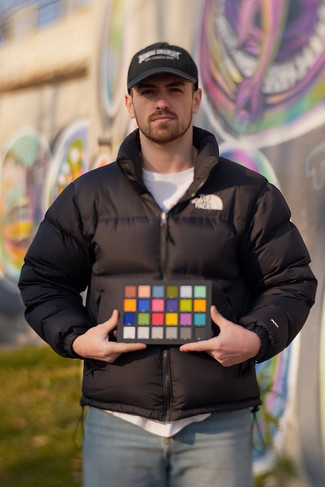Sony a6700 vs Sony a7IV Color Profiles: Differences and How to Match Them
- Veres Deni Alex
- Feb 6
- 4 min read
Updated: Mar 6

Last year, Sony sent me multiple cameras and I compared them with a couple film simulations. My goal was to show how each camera handles colors and how to color match older Sony cameras with newer models.
A lot of people kept asking about the Sony alpha 7 IV and whether I could do a side-by-side with it. Luckily, my friend Petru has one. Not only did he let me borrow it for the test, but he also showed up with the Petzval 55 f/1.7 MKII Art Lens, which is an absolute gem.
For this comparison, I tested both cameras at different Kelvin values—2500K, 3200K, 5500K, and 9900K—to see how they handle both cold and warm tones. And I tested both cameras with 2 popular Sony film simulations, namely Fuji400h and Kodak Gold 200. This is especially helpful to know when you want to calibrate either cold or warm film simulations on your Sony a7IV.
The differences between the Sony A6700 and A7IV are minimal and mostly noticeable only in side-by-side comparisons— even then, they remain subtle. Only slight adjustments are needed to match the two cameras.
Good to know
At extreme temperature points like 2500K and 9900K, Sony cameras behave differently, with noticeable shifts in color balance. I call this "extreme point color shifting." For example, at 2500K, the Sony RX100 VI leans heavily toward cyan, while the Sony a7III shifts strongly toward magenta. If you're interested in learning how to color match the RX100, a7III, and a6700, I’ve covered it in detail in this article.
So without further ado, let's dive deep into the comparison.
Table of contents
Sony a7 IV vs Sony a6700 Colors - at different Kelvin values
Sony a7IV vs Sony a6700 - 2500K
Sony a7IV vs Sony a6700
Starting at the cooler end of the spectrum, 2500K - the Sony a6700 holds steady with a pretty balanced tone, sitting comfortably in the middle of the color spectrum.
The a7IV? It veers toward magenta.
Sony a7IV vs Sony a6700 - 3200K
At 3200K, the color differences between these two cameras become even more obvious. The Sony a7IV continues to lean magenta, making it stand out compared to the a6700.
Sony a7IV vs Sony a6700 - 5500K
At 5500K, the differences between the a7IV and a6700 are subtle but still worth noting. Both cameras produce natural colors under daylight conditions, but the a6700 leans slightly warmer.
One of the most noticeable differences? Greens. The a6700 gives you a warmer, olive-like green, while the a7IV shifts toward a cooler, cyan-toned green. Reds on the a7IV also pick up a magenta tint.
Sony a7IV vs Sony a6700 - 9900K
At 9900K, the a7IV continues to favor cooler tones, with a slightly magenta shift.
Fuji400H film simulation on the Sony a7IV vs a6700
Before Adjustments
When applying the Fuji400H film simulation to both the a7IV and a6700, the color differences are subtle but noticeable. The a7IV leans colder with a touch of magenta.
To correct this on the 7 IV, I lifted Kelvin by +200 and pushed the Color Filter towards green by +0.5, to balance out the magenta cast.
P.S - you can get the Fuji 400h film simulation for free!
After Adjustments
One more thing you could do to get them even closer is shift the color phase by +1 or +2 on the a7IV. But even so, the results come very close as they are.
Kodak Gold 200 film simulation on the Sony a7IV vs a6700
Before Adjustments
Next up, the Kodak Gold 200 film simulation. As expected, the a7IV shows a bit more magenta and a cooler overall feel compared to the a6700. The a6700 stays warmer, which is closer to the Kodak Gold look you’d expect.
Like with Fuji400H, the a7IV’s magenta shift is noticeable here. But don’t worry, it's fixable.
To fix these issues, I applied similar adjustments as before - lifted the Kelvin by +200 and pushed the Color Filter +1 stop towards green.
After Adjustments
A general rule of thumb
I have to admit, I’m pretty impressed by how closely the Sony a7IV matches the newer a6700 in terms of color, even though the a7IV tends to be slightly colder and magenta-leaning. The differences are marginal, so you probably won’t notice them unless you put the two cameras side by side, like I did in this comparison.
The biggest thing to watch for is the a7IV’s magenta-shifted reds, which can be particularly noticeable in the Kodak Gold 200 film simulation. His skin tones were pinkish, but this was easily fixed by simply lifting the temperature and pushing a bit more green into the image with the color filter settings.
General rule of thumb for adjusting the film recipes on the Sony a7 IV 👇
For cold film recipes - increase the temperature by 200, push the color filter towards green by 0.5, and lastly lift the color phase by +1 or +2 levels.
For warm film recipes - increase the temperature by 200, push the color filter towards green by 1 stop. That's it.
So, if you’re wondering whether the a7IV’s colors are drastically different from the a6700, the answer is no—at least not in a way that’s going to wreck your workflow. And with just a few quick adjustments, you can make them match. Just use these settings, depending on the recipe.
I've written a couple of articles on color matching film simulations across cameras, these will help you get the gist of matching colors in-camera.
You can test these settings on the free film simulation for Sony & get your JPEGs to look more like film!
You can post your work on the Forum or the Official Sony film simulation Subreddit.
Thank you for stopping by! :]



























